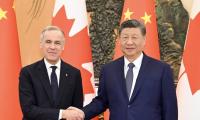Increase in Pakistan’s energy consumption depicts higher economic activities
LAHORE: Although Pakistan lags far behind India and China in GDP growth, its primary energy consumption increased by 5.9 percent to 78.2 million ton oil equivalent (MTOE) in 2015, compared with 73.2MTOE in 2014 depicting higher economic activities.
Energy consumption is a barometer for the state of the economy of the country. The impact of higher energy consumption on GDP growth is manifested after a lag period of two to three years. This is because the energy consumed in improving infrastructure, installation of new industrial projects does not turn in to immediate economic benefits. The countries where economic growth slows, register low increase in energy consumption.
According to the statistical data of British Petroleum on energy use around the world, the primary energy consumption in China grew by 1.12 percent from 2014 to 2015 that has resulted in slowdown in China’s economy. India’s primary energy consumption increased by 5.1 percent during the same period which is lower than that of Pakistan. Indian GDP growth, though highest in the world remains much below the peaks it attained at the start of this decade.
The fuels consumed for producing primary energy show that in 2014, Pakistan consumed 22.8MTOE of oil that increased to 25.2MTOE in 2015. Its natural gas use also increased from 37.7MTOE in 2014 to 39.0MTOE in 2015. The consumption of coal remained the same at 4.7MTOE in both years.
According to the report, electricity consumption in Pakistan increased from 96.2 terawatt-h in 2008 110.0 terawatt-h in 2015. The increase was restricted to 99.3 terawatt-h till 2012; showing cumulative increase of 4 percent only, but in the next three years the consumption cumulatively increased by 10.7 percent of which 2.7 percent increase was in 2015 over 2014. Indian electricity consumption in comparison increased more robustly being 833.4 terawatt-h in 2008 that increased to 1,304.8 terawatt-h in 2015.
This means that Indian production of electricity in 2008 was 8.9 times more than Pakistan and in 2015 it was 13 times higher. This difference in power use explains the great stride India has made economically during the period in question. Nuclear power provided 1.1MTOE primary energy in 2014 and the same quantity in 2015. Hydro electric production increased from 7.4MTOE to 7.8MTOE in 2015. The renewable energy production increased from 0.2MTOE in 2014 to 0.4MTOE in 2015.
India produces 45.5MTOE from natural gas, 407.2MTOE from coal that is 100 times more than the primary energy that Pakistan derives from coal. Its hydro electric generation is 8.6MTOE. It derives 15.5MTOE from renewable that is 30 times more than what Pakistan obtains from renewable. The primary energy obtained by China from natural gas is 177.6MTOE, from coal it is a whopping 19,203MTOE. Its hydro electric energy amounts to 254.9MTOE, nuclear 38.6MTOE and renewable 62.7MTOE. The renewable energy extracted by China is equivalent to 60 percent of the total energy produced in Pakistan.
Bangladesh in 2008 consumed only 34.2 terawatt-h electricity that was almost 1/3rd of the power consumption in Pakistan. In 2015 the gap was reduced to 60 percent of the power consumed in Pakistan. Bangladesh is exporting much more than Pakistan despite low power use because it adds high value to its apparel. The power requirement of the garment industry is nominal when compared with spinning, weaving and processing that produce low value-added textiles exported by Pakistan. The electricity consumption in China increased to 5,810 terawatt-h in 2015 compared with 3495 terawatt-h in 2008.
Coal, wind and solar energy are the cheapest source of energy around the world. Wind and solar along with hydro electricity are the cleanest energy fuels. China fulfilled 1,920MTOE of its energy needs from coal, India 388.7MTOE, and Pakistan only 4.7MTOE. Coal use for energy production is confined only to the private sector in Pakistan. Around 3,000MW coal based power plants are expected to be commissioned by 2019 after which share of coal in the energy mix would substantially increase. Wind power consumption in China was 41MTOE in 2015, it was 9.4MTOE in India and only 0.1MTOE in Pakistan. Solar power production in 2015 was 8.9MTOE in China, 1.5MTOE in India and only 0.3MTOE in Pakistan. Pakistan is also on the course to double its hydro electric production to over 16,000MW by the end of 2021.
-
 Michelle Randolph Clears The Air On Dating Rumours With Glen Powell
Michelle Randolph Clears The Air On Dating Rumours With Glen Powell -
 Viral 2016 Throwback Trend Taking Over Instagram And TikTok: Here's Why
Viral 2016 Throwback Trend Taking Over Instagram And TikTok: Here's Why -
 Wizards Vs Kings: Domantas Sabonis Returns After 27-game Absence
Wizards Vs Kings: Domantas Sabonis Returns After 27-game Absence -
 Bella Hadid Shares Future Plans Following 'Yellowstone' Success
Bella Hadid Shares Future Plans Following 'Yellowstone' Success -
 NLL Brings Professional Lacrosse Back To Edmonton After 10 Years
NLL Brings Professional Lacrosse Back To Edmonton After 10 Years -
 Marcello Hernandez’s Girlfriend: What To Know About Ana Amelia Batlle Cabral
Marcello Hernandez’s Girlfriend: What To Know About Ana Amelia Batlle Cabral -
 Sources Dish On Andrews Plans For Life After Exile To A Falling Down Dump
Sources Dish On Andrews Plans For Life After Exile To A Falling Down Dump -
 Snow Storm Warning In Ontario’s Weather Forecast Through Tuesday
Snow Storm Warning In Ontario’s Weather Forecast Through Tuesday -
 Canada And China Trade Deal: All You Need To Know About The New Agreement
Canada And China Trade Deal: All You Need To Know About The New Agreement -
 Tyler Hilton, Megan Park Call It Quits After 10 Years Of Marriage
Tyler Hilton, Megan Park Call It Quits After 10 Years Of Marriage -
 Prince Harry’s Fears Turn Concerning As Archie, Lilibet Slip Too Far Out Of Reach: ‘Their Too American’
Prince Harry’s Fears Turn Concerning As Archie, Lilibet Slip Too Far Out Of Reach: ‘Their Too American’ -
 Former Nickelodeon Star Kianna Underwood Dies At 33 In Tragic Hit-and-run
Former Nickelodeon Star Kianna Underwood Dies At 33 In Tragic Hit-and-run -
 Prince Harry Risks Straining Marriage To Make Archie, Lilibet Make Emotional Demand Of Meghan
Prince Harry Risks Straining Marriage To Make Archie, Lilibet Make Emotional Demand Of Meghan -
 Sarah Ferguson’s Pal Reveals What She Really Thinks Of Beatrice, Eugenie Choosing A Royal Christmas
Sarah Ferguson’s Pal Reveals What She Really Thinks Of Beatrice, Eugenie Choosing A Royal Christmas -
 North West Raps About Piercings, Tattoos And Skipping School In New Song
North West Raps About Piercings, Tattoos And Skipping School In New Song -
 Teddi Mellencamp Shares Hopeful Health Update Amid Cancer Battle: 'Cloud Is Lifting'
Teddi Mellencamp Shares Hopeful Health Update Amid Cancer Battle: 'Cloud Is Lifting'



